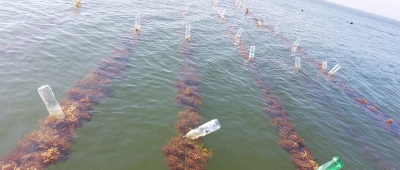The Department of Agriculture’s Bureau of Fisheries and Aquatic Resources (DA-BFAR) officially launched the National Aquaculture Development and Management Plan (ADMP) 2025-2030. The ADMP, the first-ever development and management plan of the Bureau solely dedicated to aquaculture, aims to address the complexities of the aquaculture industry in the country and outlines a strategic framework for advancing the sector in the Philippines. The plan seeks to enhance the industry’s sustainability, productivity, and contribution to the national economy, while tackling critical challenges such as environmental impacts, resource management, and market competitiveness.
During the launch, DA-BFAR Officer-in-Charge Director Isidro Velayo, Jr. stressed the importance of the ADMP in guiding the future of the country’s aquaculture sector and urged all sectors to collaborate. “The vision and goals laid out in the 2025-2030 ADMP underscore our commitment to a socially equitable, sustainably managed, climate-resilient, and globally competitive aquaculture industry. This plan emphasizes the importance of fairness, ensuring that all stakeholders, particularly those from marginalized sectors, have equitable access to resources and opportunities. It promotes responsible stewardship of our environment, enabling the industry to thrive without compromising ecological balance,” Director Velayo said. “As we pursue these goals, collaboration will be key. I urge all sectors private and public alike, including our partners in local government units, national agencies, and government-owned and controlled corporations to come together in the spirit of shared responsibility,” he added.
Developed through an extensive series of consultations with industry stakeholders, experts, local government units, environmental groups, and government agencies, this five-year aquaculture plan will serve as a roadmap for developing a competitive aquaculture sector that meets local and global demands, while promoting the sustainable management and development of the country’s fisheries and aquatic resources over the next five years. It is designed to support collaboration and align goals across the aquaculture sector and its partners.
The ADMP also envisions a socially equitable, sustainably managed, climate-resilient, globally competitive, and profitable aquaculture industry. Several key goals have been identified: ensuring an adequate supply of good quality seed stocks, fostering an inclusive aquaculture environment across different socio-economic sectors, optimizing and reducing production costs of aquaculture commodities, strengthening the resilience and adaptability of aquaculture production, safeguarding the welfare of the environment within and adjacent to aquaculture farms, reducing friction between production and post-harvest activities, bolstering the development and adoption of post-harvest equipment and facilities, diversifying the range of aquaculture products and enhancing their marketability, increasing the competitiveness of aquaculture products in international markets, empowering producers through direct marketing initiatives, cooperative models, and strengthened supply chain management; and strengthening aquaculture governance for the efficient delivery of aquaculture services.
The ADMP also aligns with the current realities and objectives of the Comprehensive National Fisheries Industry Development Plan (CNFIDP) 2021-2025, a comprehensive and strategic framework designed to promote sustainable development and optimal utilization of the country’s fisheries resources, ensuring long-term economic, social, and environmental benefits and the FAO Blue Transformation Roadmap 2022-2030 and FAO and NACA Aquaculture Transformation. The ADMP Technical Working Group referred to these international documents to make sure that the ADMP to be developed is aligned with the goals of these documents. Given that the CNFIDP is nearing its conclusion, it is anticipated that these goals will be achieved through the ADMP, particularly the unmet key performance indicators of the CNFIDP. Moreover, the plan highlights the importance of collaboration between government agencies, the private sector, and local government units in implementing projects and programs under the ADMP. This collaborative approach ensures that the plan addresses the needs and concerns of all relevant parties in the aquaculture sector. To date, the aquaculture sector is one of the main drivers of fisheries production in the country. Data from the Philippine Statistics Authority (PSA) show that aquaculture production reached 2.38 million tonnes in 2023, with an approximate value of Filipino Peso 124.02 billion. Most of the aquaculture production came from seaweed, contributing 1.63 million tonnes, or 68.2%, to the country’s total production. This data underscores the important role of the aquaculture sector in boosting national fisheries production, contributing significantly to both economic growth and food security. With the National Aquaculture Development and Management Plan in place, DA-BFAR is optimistic that the country’s fisheries sector will continue to grow, enhance productivity and secure livelihoods for millions of Filipino fisherfolk, ultimately contributing to national food security.

